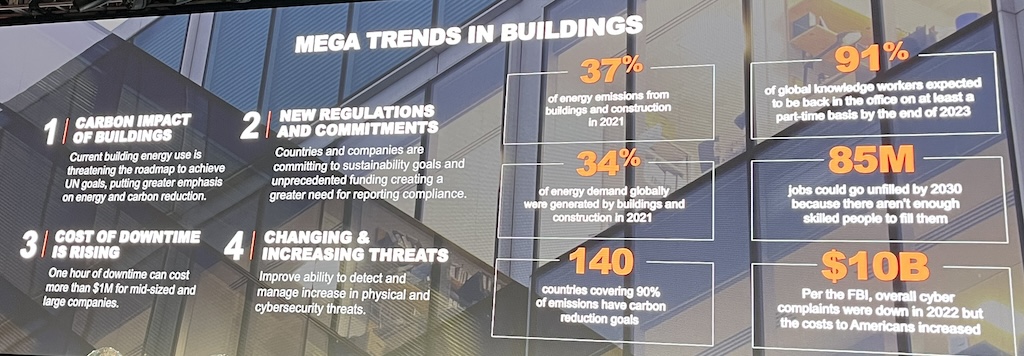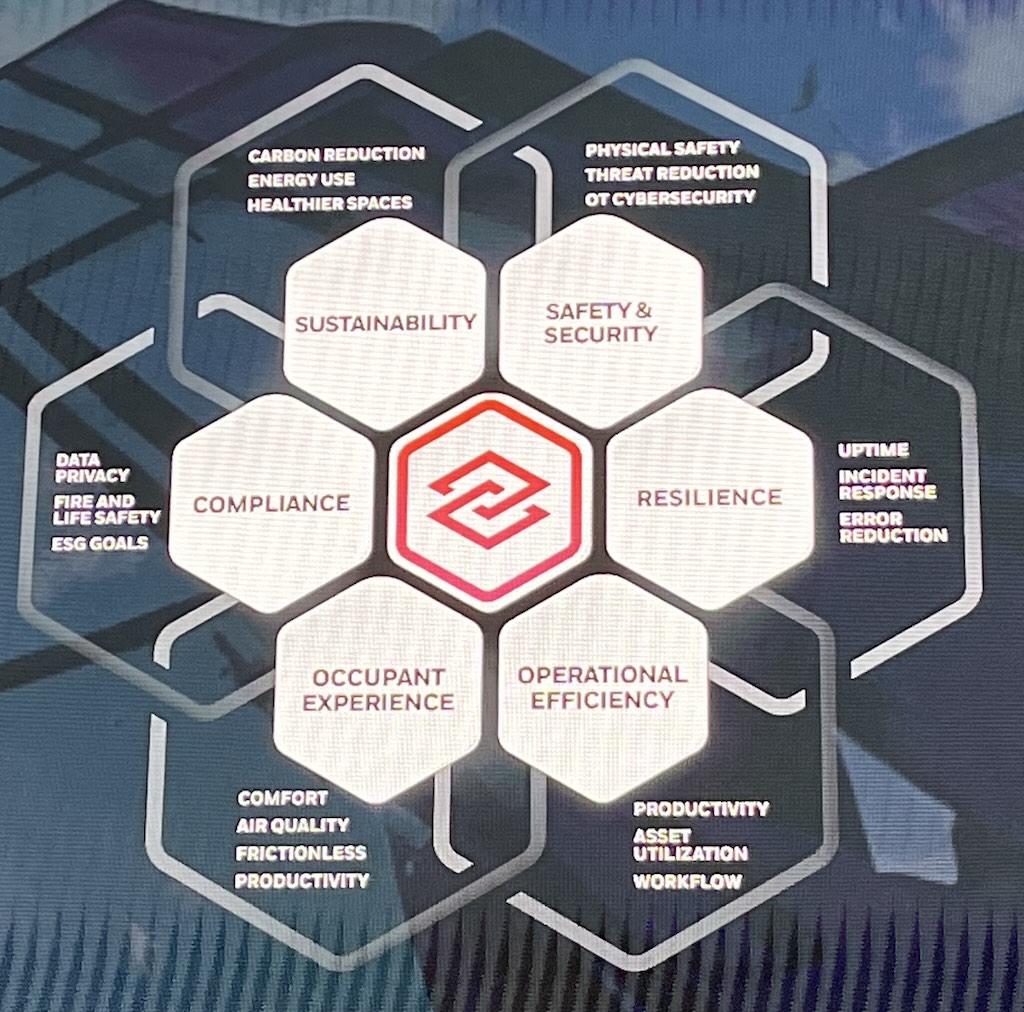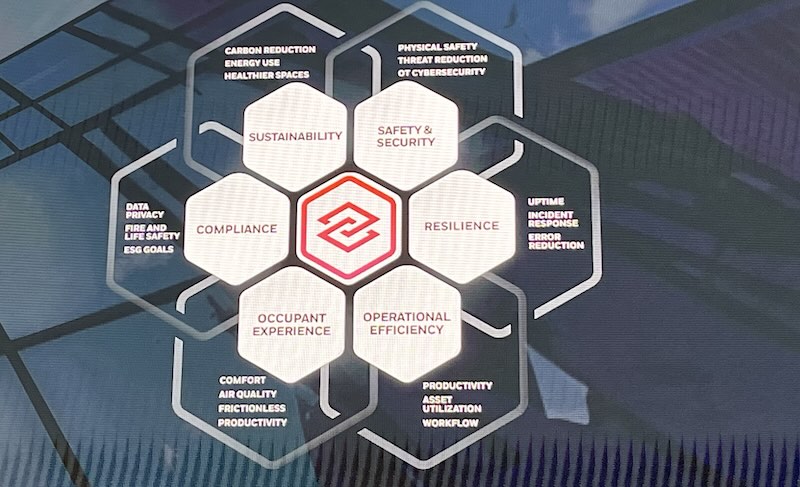Honeywell Connect Recap: Using digital technologies to improve building intelligence, sustainability
Digital technologies can help building owners and managers get a more comprehensive look at emissions, power generated and more in real-time.
Building transformation insights
- Digital transformation emphasizes future improvements across industries, with a focus on reducing carbon emissions and enhancing building automation.
- In the building sector, addressing carbon emissions and optimizing building automation are critical challenges, constituting 37% of global energy emissions. Digital technologies offer solutions for better efficiency and sustainability.
The second Honeywell Connect event highlighted many of the same themes from the first show last November: Emphasizing digital transformation to improve operations, intelligence and make workers more efficient and safer. This time, with the show in Dallas rather than Orlando, Honeywell’s emphasis, according to Honeywell Connected Enterprise president and CEO, Kevin Dehoff, is about learning from their customers and using those lessons to improve the future regardless of industry.
This is part of a larger effort by Honeywell as they announced plans to realign its business segments to three trends: Automation (building and industrial), aviation and energy transition. According to a statement released during the event, this shift is intended to deliver accelerated organic sales growth and inorganic capital deployment, creating greater value for shareholders. The new segmentation will take effect beginning first quarter 2024.
In the building technology world, two challenges persist: Reducing carbon emissions and make building automation smarter. While the two are linked in some ways, they remain challenges that have an impact on not only the owners and the people working or living inside the buildings, but the world as a whole.
“We’re seeing a huge electrification trend happening,” said Manish Sharma, VP and chief product office. “Electric vehicles are one and the second one is the heat pump. A lot of facilities use boilers, but they’re shifting toward the heat pump. Europe is pretty ahead, but the U.S. is catching up. Every building has a higher degree of inefficiency depending how you manage the building, assets, occupancy. Global regulations and standards are coming.”

Major trends building owners face include the impact of carbon emissions on buildings, new regulations, greater cybersecurity threats and more. Courtesy: Chris Vavra, CFE Media and Technology
Udaya Shrivastava, VP and CTO for Honeywell Building Technologies, said buildings, when the construction and operations are combined, account for 37% of energy emissions in the world. “It is important to have a holistic view of the building’s operations,” she said.
Bilal Hammoud, president and CEO of Honeywell Building Technologies, said, “We’re working to identify where emissions are coming from and recognize utilization parts. Optimize as you go. Integrated future with multiple inputs from within and outside the building.”
Digital technologies can help building owners and engineers learn what’s being emitted and finding out where they’re strong and weak and maximizing efficiency.
“In the building domain, it’s about utilization patterns and how they work to deliver the outcome desired,” said Bilal Hammoud, president and CEO of Honeywell Building Technologies.
That’s easier said than done with building owners and managers dealing with labor shortages and increased cybersecurity threats, which is new terrain for many building owners as they grapple with smart building technology. Shrivastava said it is leading to unplanned expenses, unplanned operations and undesired occupant outcomes.
In an ideal world, she said, successful building management will lead to six key outcomes:
-
Better sustainability such as reduced carbon emissions and healthier building spaces.
-
Improved safety and security from a cybersecurity standpoint as well as physical.
-
Greater resilience such as improved uptime and incident response.
-
Operational efficiency such as productivity and asset utilization will increase.
-
The occupant experience will be more comfortable and the air will be easier to breathe.
-
Building compliance related to fire and life safety, data compliance and environmental, social and governance (ESG) will be greater.

Successful building management will improve sustainability, safety and security, resilience, operational efficiency, occupant experience and compliance. Courtesy: Chris Vavra, CFE Media and Technology
Utilizing and enhancing data access in educational facilities
Honeywell emphasized their Forge digital transformation software, which is designed to help people get access to the information they need in real-time so they can make better decisions. While manufacturing plants and large buildings might come to mind, digital technology can help others, too. In one case, Jisc, a not-for-profit company that provides IT services, utilized all the data to help education institutions in the United Kingdom.
“Historically, the data locked away has been available to certain people,” said Victoria Atherstone, an innovation consultant for Jisc. “Being able to make this data regularly available to a broad array of stakeholders helps us make data-driven decisions about energy efficiency, sustainability and student decisions to make things better for them.”
It’s a comprehensive look, Atherstone said, and being able to pull the data through the platform and receiving real-time data analytics gives the people reviewing the information better insights such as much energy is being consumed and waste being produced. They also can use the information to determine when to heat or cool a building depending on occupancy rates so they aren’t wasting energy, which improves the overall bottom line.
Valentin Deagu, head of property and facility management at Globalworth, also sees the benefit of digital transformation.
“The richness of the data is refined and given to greater insights. Digital transformation enables and provides added value,” he said, adding it also can help uncover opportunities to steer towards decarbonization and processes that have a positive effect on the environment.
Sharma does see a bright future ahead. “Lot of customers have taken the pledge and taken it to their shareholders and made the commitment, which is good. Many customers are in different parts of their journeys. Some are far along. They understand what they need to do and what projects they want to run, but those are very few in my opinion. We need to make invisible visible, which is the data. From there, you can go from visibility to control.”
Chris Vavra, web content manager, CFE Media and Technology, cvavra@cfemedia.com.
Do you have experience and expertise with the topics mentioned in this content? You should consider contributing to our CFE Media editorial team and getting the recognition you and your company deserve. Click here to start this process.


